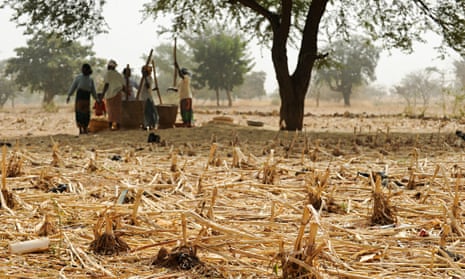One afternoon towards the end of May a violent wind howled through Bogandé, the main town in Gnagna province, in eastern Burkina Faso. Raising a storm of dust and sand, it plunged the streets into semi-darkness, driving roaming goats crazy. In villages across Gnagna people connect these extreme climate events with deteriorating living standards. They explain how these increasingly frequent “red” winds wreak havoc, burying their crops in sand, destroying their homes, and spreading disease among their flocks.
In late May, on the great Gnagna plain, the earth is dry, with deep cracks. An occasional tree – usually red acacia (Vachellia seyal) – stands out as a patch of green. In the villages, most of the wells have dried up. It is the toughest part of the year, when reserves from the previous harvest run low and the next one is not yet ripe. And still there is no rain.
In 2014, just 538mm of rain fell here. Over the past 30 years, average annual rainfall has dropped by 200mm. “The Sahel climate zone is steadily spreading further south. Bogandé used to enjoy a Sudanese-Sahelian climate, but it is now borderline,” says Claire Gaillardou, head of the risks and disasters department at the Action Against Hunger (ACF) mission in Burkina Faso. “Since 1975 the [average] temperature has risen by 0.8C.”
Tnidano Tissa, 78, remembers how the village looked when he was a child. “There were great African mahogany, locust bean, fig and shi trees, all of which produced fruit. In the rainy season, long grass protected the ground. All year long there was a bit of plant cover. We’d see antelopes, big savannah monitors and hyenas,” he says, drawing a smile from the youngest members of his audience, who have never seen such creatures.
The plant cover has vanished, and trees are now a rarity. With diminishing rainfall, the soil is blown away by winds that grow ever more violent. “There are no longer any trees to slow them down,” says Lankoandé Diagnogou, 38, a neighbour of Tissa’s.
At Tindandou, 45km away, Diawari Barbibilé, 63, is equally desperate. “The loss of plant cover has speeded up soil degradation, and the rainy season is very short,” he says.
The rain comes later and is interspersed with long periods of drought. Across the region, rainfall is increasingly erratic and increasingly intense. The rain cuts into the ground and washes away the little humus – which is essential to the fertility of the earth – it contains.
“That, in turn, can cause flooding, because water has difficulty penetrating bone-dry earth. Some years the run-off rate can be as high as 40%,” Gaillardou explains. ACF is trying to help communities adapt to these extreme climate events, which seem to get steadily worse. Assistance involves learning farming techniques that keep the water in the soil and reduce the effects of erosion.
This year Barbibilé prepared three one-hectare fields, digging semi-circular hollows along the contour lines to trap as much rain as possible and create better conditions for sowing. He hopes this technique will yield a bigger crop.
Ten years ago, Barbibilé was still harvesting “five cartloads” of grain. “We could live very nicely on what I grew, and I could sell the surplus,” he says. “But in the last few years the soil has become so poor that I don’t have anything to sell. The two cartloads I bring home are barely enough to feed the family. The rest of the crop is only fit for cattle-feed.”
His 34-year-old son works with him now, and in all there are 16 mouths to feed. “The rain stops before the millet has even had time to fully ripen. If there’s no rain what you grow is worthless,” Barbibilé says. Due to the unpredictable rainfall he has had to give up the traditional crop of sorghum, which takes longer to ripen. He prefers to use white sorghum and pearl millet, with a shorter crop cycle.
In Burkina Faso in late May, as they waited anxiously for the next crop, more than 330,000 people faced food insecurity. In Gnagna province, with an average of seven people in each household, the situation is far worse than in the rest of the country. Farmers are producing less than half the food they need to survive. After four to six months their reserves run out. In the worst years, they have no option but to sell part or all of their livestock – if they have any – or run up debts.
“When we run short of food, we have to turn to one of our neighbours in the village who has sufficient resources to lend us food,” says André Dori, 38, who lives in Kongaye, in Gnagna province. Dori, who has four children, says he too can no longer meet his family’s needs. “These loans are in kind. With a 100% interest rate: for one sack of grain borrowed, I must pay back two. I am deep in debt, because my crops don’t ripen properly, due to the climate.” He has been unable to pay off any of his debts in recent years.
Dori hopes things will get better through the use of improved techniques. With more bountiful harvests, he says, he could feed his family and even buy livestock.
This article appeared in Guardian Weekly, which incorporates material from Le Monde

Comments (…)
Sign in or create your Guardian account to join the discussion